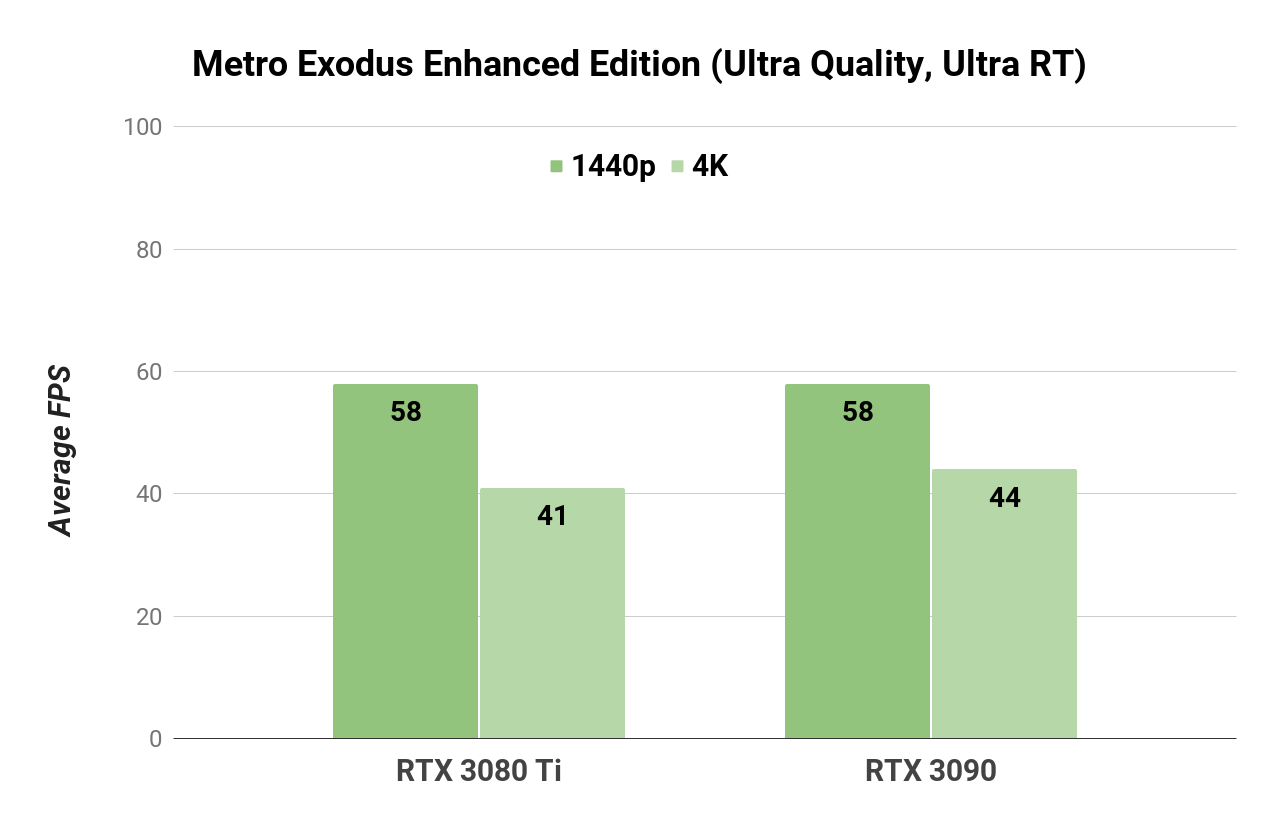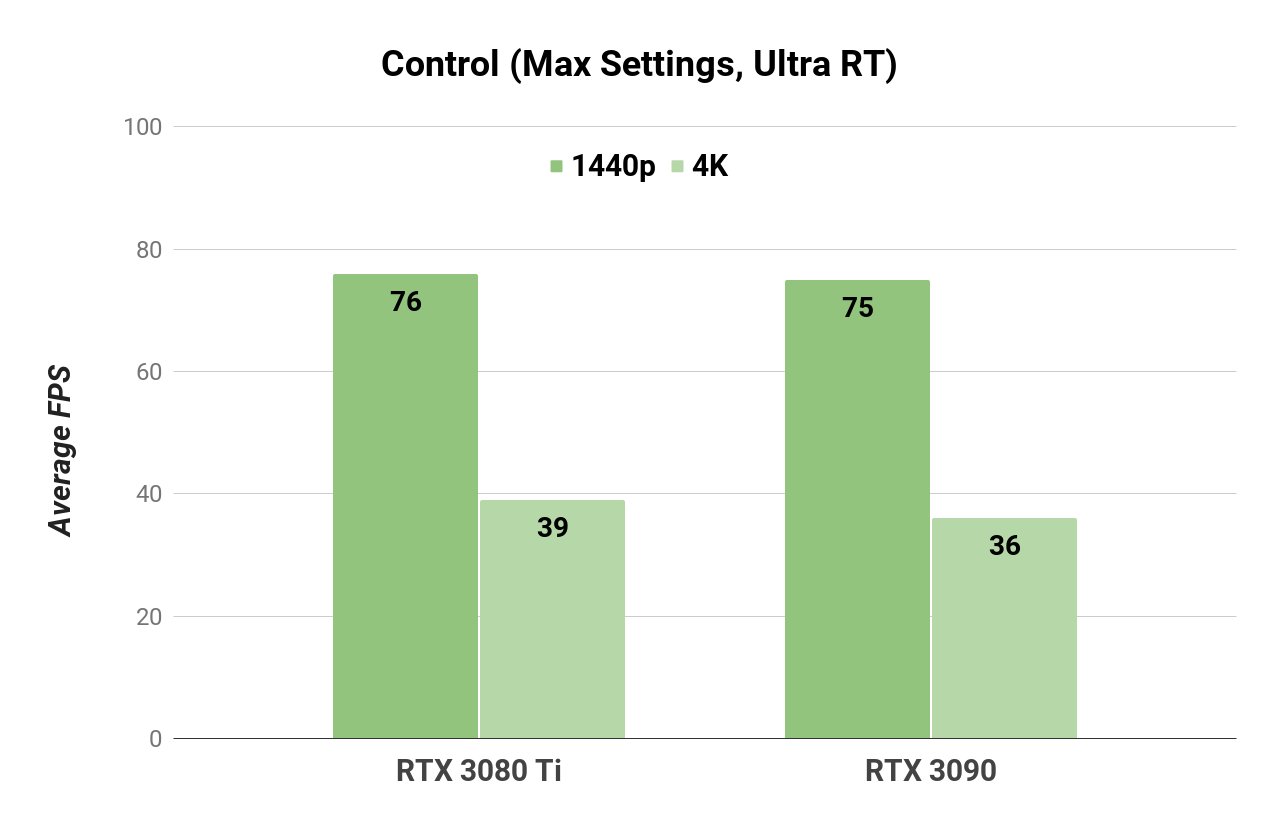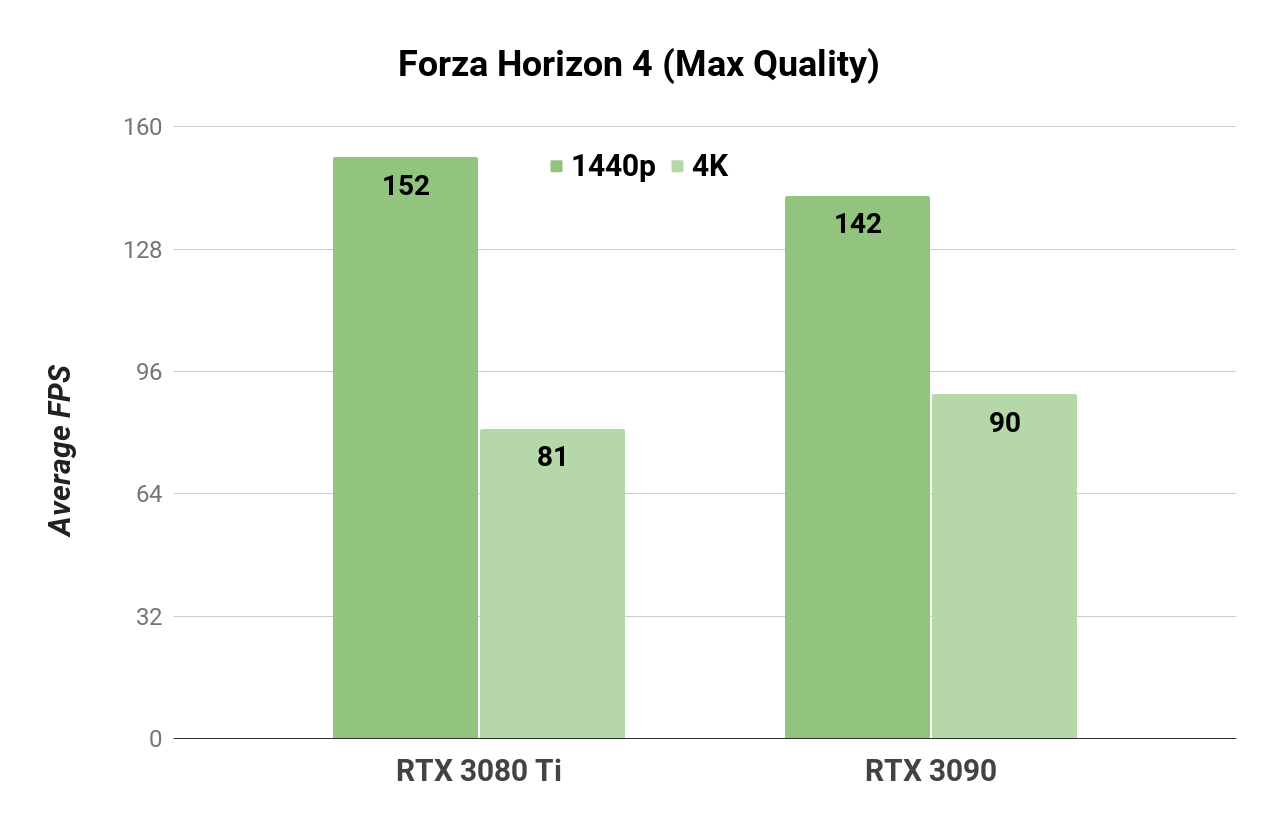It has been less than a year since Nvidia launched its RTX 30-series, but the company is already making improvements on its latest Ampere architecture with both the RTX 3080 Ti and 3070 Ti. The former, which is the focus of this review, has been tasked with carrying the moniker of "flagship gaming card" too, as Nvidia continues to market its more powerful, and more expensive, RTX 3090 for workstation use. But there's no denying that the RTX 3090 presented a compelling case for the best gaming performance on the market when it launched--a title that the RTX 3080 Ti mostly matches in every regard.
The RTX 3080 Ti ($1,200) is positioned to sit between the RTX 3080 ($700) and 3090 ($1,500), but the card is clearly designed to deliver near-3090 levels of performance without needing to have additional memory that, often, isn't utilized by even the most demanding titles of today. What that means is that you get top-tier gaming performance for $300 less without any compromises for that specific use case. Getting one becomes even more complicated when you reconcile that Nvidia's MSRP of $1200 isn't what you're likely going to purchase the RTX 3080 Ti for--the semiconductor shortage and lack of GPU supply has plagued the market for months now--which casts an entirely different value proposition on the new SKU. What isn't debatable is the card's raw performance, which delivers in spades across the board.
Technical Details
Restart NVIDIA Computex 2021 Keynote Livestream World Of Warcraft: The War Within - Shadow And Fury | Official Trailer Dead by Daylight | Dungeons & Dragons | Official Launch Trailer Metal Slug Tactics - New Gameplay Trailer | Coming Fall 2024 The Complete DESTINY Timeline Explained! Warzone & Modern Warfare III - Official Gundam Mobile Suit Bundles Gameplay Trailer Street Fighter 6 - 1st Anniversary Fighting Pass Gameplay Trailer Genshin Impact - "Clorinde: Night Vigil Amidst Candlelit Shadows" | Character Demo Genshin Impact - "Sethos: Revelation of the Silent Sands" | Character Demo REYNATIS - NTWEWY Official Crossover Trailer The Status of Every PlayStation Franchise Call of Duty: Game Pass' Savior? | Spot On
Please enter your date of birth to view this video
By clicking 'enter', you agree to GameSpot's
Terms of Use and Privacy Policy
Nvidia supplied us with a Founder's Edition model of the RTX 3080 Ti for review, ahead of its launch on June 3. The card is identical to the RTX 3080 before it--it is a dual-slot design that features three DisplayPort outputs and a single HDMI 2.1 output. The Founder's Edition retains the new dual-fan design that redirects warm air upwards into the case as well as exhausting through the rear, which has worked extremely well for the cards that launched last year. The illuminated GeForce RTX logo on the side and minimal lighting on the top are still nice touches, and the mandatory 12-pin power adapter on the side still requires the use of an included splitter that will still ruin the clean, clutter-free look inside your case.
The biggest changes are inside. Nvidia has significantly beefed up every aspect of the previous RTX 3080 with this Ti variant featuring additional CUDA cores, Tensor cores, RT cores, and more. Its boost clock is lower as a result, with the new peak of 1665Hz (bringing it closer to the RTX 3090.) The biggest upgrade is its VRAM, which has been increased from the criticized 10GB in the RTX 3080 to 12GB of GDDR6X for the 3080 Ti. That, in combination with a wider 384-bit memory bus, gives the RTX 3080 Ti a memory bandwidth of 912GB/s, a massive increase over the 760GB/s of the RTX 3080. This bandwidth is just shy of the capabilities of the RTX 3090, but that card still features far more VRAM with its 24GB GDDR6X configuration.
| RTX 3090 | RTX 3080 Ti | RTX 3080 | |
|---|---|---|---|
| GPU Clusters | 82 | 80 | 68 |
| CUDA Cores | 10496 | 10240 | 8704 |
| RT Cores | 82 | 80 | 68 |
| Tensor Cores | 328 | 320 | 272 |
| ROPs | 112 | 112 | 96 |
| Boost Clock | 1695 MHz | 1665 MHz | 1710 MHz |
| Memory | 24GB GDDR6X | 12GB GDDR6X | 10GB GDDR6X |
| Bus | 384-bit | 384-bit | 320-bit |
| Bandwidth | 936 GB/s | 912 GB/s | 760 GB/s |
| TDP | 350W | 350W | 320W |
| Price | $1,500 | $1,200 | $700 |
Methodology and Test Bench

Our testing methodology for this card is slightly different from the one used for previous graphics card reviews, mostly due to a different system being used for the tests. As a result (and due to the other GPUs we had on hand to run additional testing on) the results we've gathered directly compare the RTX 3080 Ti to the Founder's Edition RTX 3090. Tests were all run using Nvidia's pre-release 466.47 driver. Testing was done on the following system:
- MSI Mortar B550M Motherboard
- AMD Ryzen 5 5600X 6-core/12-thread CPU clocked at 4.65GHz
- Noctua NH-U12S CPU Cooler
- Corsair Vengeance DDR4-3200, CL16 RAM (2x16GB dual-channel DIMMs)
- Corsair Hxi Series HX850i (80mPlus Platinum) PSU
- Intel 660p 2TB NVMe SSD
It's worth noting that while the AMD Ryzen 5 5600X is far from the flagship in AMD's CPU lineup, it's unlikely to have an appreciable effect on tests at 1440p, and no effect at 4K, as both of these scenarios are GPU- rather than CPU-limited.
Testing was done across nine modern games, all of which feature elements of ray tracing, DLSS support, or various other graphical flourishes. These include Cyberpunk 2077, Control, Shadow of the Tomb Raider, Metro Exodus Enhanced Edition (which makes some substantial changes to the game), Borderlands 3, Gears Tactics, Forza Horizon 4, Horizon Zero Dawn, and Hitman 3. Where possible, in-game benchmark tools were used, otherwise FRAPS was utilized for measuring an in-game run of a section (which was done for Control and Cyberpunk 2077).
Given the cards being tested, the results represent performance at 1440p and 4K, with 1080p omitted due to its irrelevance at this price point. Additionally, all games were run at their maximum presets, including ray tracing options when they were offered. DLSS was kept off for most of the runs but is represented in later tests to show the performance uplift when compared to native rendering.
With that out of the way let's dive into some, surprisingly, very similar numbers.
Benchmark Results
Metro Exodus Enhanced Edition

Metro Exodus was recently updated with developer 4A's comprehensive rework of the game's engine, allowing for one of the most impressive showings of ray tracing to date. It's the perfect workload for Nvidia's best cards, both of which manage to achieve nearly identical metrics across the board.
There's nothing splitting the two when looking at 1440p, but at 4K the RTX 3090 takes a slight lead with about 7% more performance, or just 3 frames per second.
Control

Control is still one of the best ray tracing showcases out there, with Remedy's impressive reflection work really bringing the Oldest House to life. Working through an early portion of the game, performance metrics were captured with FRAPS while trying to keep as close to identical playthroughs as possible.
Again, in what will be a running theme in ray-traced workloads, there's very little splitting the two cards. In fact, Control represents one of the first instances where the RTX 3080 Ti starts pulling ahead, with around 8% more performance at 4K and near a negligible difference at 1440p.
Cyberpunk 2077

Cyberpunk 2077 is still receiving numerous patches to address its performance (among other issues) which makes a great stress test for powerful GPUs. Roaming through the game's Downtown area along a fixed path, FRAPS was used to capture the run and record metrics.
Unsurprisingly, Cyberpunk 2077 with all its ray tracing at Ultra and no DLSS is a tough task for both cards, and one that the RTX 3090 is slightly better suited for. But again, the differences are small enough to be within margins of error, putting both nearly on par with each other regardless of the resolution.
Horizon Zero Dawn

The former console exclusive has been steadily updated on PC to make up for its less-than-stellar launch, and right now Horizon Zero Dawn is a pretty performant game across a range of hardware. The game's benchmark isn't the best test of the engine, but it does provide us with a consistent run that both cards were tested on.
Here, without any ray tracing to speak of, the RTX 3090 does take a slender lead with the rasterization-exclusive workload, but again it's within a frame or two at both 1440p and 4K that the differences are within margins of error.
Shadow of the Tomb Raider

Shadow of the Tomb Raider was one of the earliest games to implement its ray-traced shadows, and it's still an intense workload for modern cards when taking them through the game's numerous benchmark scenes.
At 1440p the RTX 3080 Ti takes a slight lead and manages to break triple digits in terms of average frame rate, but there's nothing to split the two when looking at 4K.
Borderlands 3

Borderlands 3 and its art style might not immediately suggest a performance heavy title, but its "Badass" preset still manages to stress both cards considerably at higher resolutions.
The advantage of the RTX 3080 Ti is slightly more pronounced here at 1440p but, again, both cards are neck and neck when increasing the resolution up to 4K. Irrespective, you're getting higher than 60fps in both cases, which is great.
Hitman 3

Hitman 3 is one of the most recently released titles in this suite of tests, but also one of the games that seems to be a breeze for both flagships even at 4K. Sweeping through the game's Dubai benchmark produces amazing results that will really make a high refresh rate monitor come in handy.
Like Borderlands 3, the differences between the two cards go in favor of the RTX 3080 Ti, with a near 8% performance uplift at 1440p. At 4K things are more even, with both cards capable of breaking triple digits.
Forza Horizon 4

Forza Horizon 4 remains one of the best-looking racing games out there. It's especially great on PC where you can improve image quality across the board compared to console, making it a great test for both cards.
Here the RTX 3080 Ti takes a lead at 1440p, with around 7% better performance over the RTX 3090. Surprisingly, the tables turn at 4K, with the RTX 3090 taking a 10% lead.
Gears Tactics

Gears Tactics is intense on both your GPU and CPU, and its randomized benchmark is great at measuring bottlenecks across both. With all of the details set to their maximum it's a technically impressive showcase, too.
Here the RTX 3090 enjoys its biggest lead across the suite of testing, with a large 16% improvement over the RTX 3080 Ti at 1440p. That's even wider at 4K, with the difference sitting at 18% between the two cards.
The impact of DLSS continues to be pronounced
Nvidia's cards feature a range of proprietary software tools that add a lot of value to each GPU purchase, from the AI-powered noise-cancelling of Nvidia Broadcast to the resource-sensitive ShadowPlay gameplay capture. None of these, however, are as impactful as Deep Learning Super Sampling, or DLSS, which continues to provide large performance gains while continually improving the visual enhancements with each iteration.
If you're unfamiliar, DLSS is a supersampling and anti-aliasing technique that allows a game to render at a lower resolution (improving performance) while making up for the loss in detail with predictive AI-powered corrections to the image. It's become especially important in many titles that support ray tracing, and even more so at 4K, both of which are serious drains on performance. DLSS allows games to run faster without a very noticeable degradation in image quality, especially with the latest 2.1 iteration.

The RTX 3080 Ti, like all other cards in the RTX series, supports DLSS, and you can see from the graph above how crucial it can be to obtain better frame rates in the most demanding modern titles.
In summary (if it wasn't already clear), Nvidia's RTX 3080 Ti does live up to its billing as the company's next gaming flagship, with mostly identical performance to the RTX 3090 in purely gaming workloads. This shouldn't come as too much of a surprise either, considering how the RTX 3080 Ti features almost identical specs to its much larger counterpart.
The changes to the memory bandwidth and the TDP (up to 350W from 320W) are clear indicators of this, and this testing shows that right now games are preferring the faster memory over just stacks more of the same. The 24GB of GDDR6X memory in the RTX 3090 doesn't give it any appreciable performance advantage across these games and at these resolutions, suggesting that Nvidia's addition of 2GB for the RTX 3080 Ti might have been the perfect sweet spot.
Thermal Performance
One point of concern early on was with regards to cooling. The RTX 3090 is a massive card because of its much, much larger cooler when compared to the Founder's Edition RTX 3080. Given that the RTX 3080 Ti consumes more power than the RTX 3080 and thus expels more heat, having the same cooler could have been a potential thermal throttling issue.
Throughout testing, the RTX 3080 Ti never reached temperatures higher than 78 degrees Celsius, which was just a bit higher than the average 73 degrees Celsius of the RTX 3090 in the same chassis. What was more impressive was the readings on the memory junctions, which were a problem on Nvidia's RTX 3080 and RTX 3090 cards with memory modules reaching, and throttling, at 110 degrees Celsius. This has forced some owners to open the card and replace Nvidia's stock thermal pads with something that dissipates the heat better, but that might not be required for the RTX 3080 Ti. I didn't measure any memory junction temperatures above 95 degrees Celsius, which is almost on par with the current running temperature of my RTX 3090 after having its thermal pads replaced. It's a small but important improvement.
The card is quiet enough at this temperature, with the fans ramping up to 2000 RPM but remaining relatively silent. What was pronounced was a very audible, and annoying, coil whine, which has been an issue across Nvidia's Founder's Edition cards throughout the RTX 30-series. This was far more noticeable than the fans and was a high enough pitch that it pierced through my headphones during play sessions.
Verdict
So, the RTX 3080 Ti is undoubtedly a tangible improvement over the standard RTX 3080, and a fantastic value proposition when compared to the RTX 3090 (which costs $300 more). But in the incredibly unpredictable climate of buying GPUs right now, it's almost impossible to predict if you'll even be able to find one at Nvidia's proposed MSRP of $1,200. At that price, you still must consider your entire setup and really ask yourself if you're going to need the full brunt of this card, or if you'll be able to take advantage of its improvements enough to justify the $500 premium over the RTX 3080, an already incredibly powerful offering.
But it's difficult to make those decisions when GPU prices are in flux and continue to wildly fluctuate well-above retail. There's no telling what the real-world difference will be between Nvidia's three premium cards in terms of price, so it's harder still to try and value them according to those metrics alone. Right now, if you can find an RTX 3080 Ti for a price that makes sense for your budget and setup, it's arguably the best gaming card on the market. But don't feel the need to pay an additional premium for it just for that.